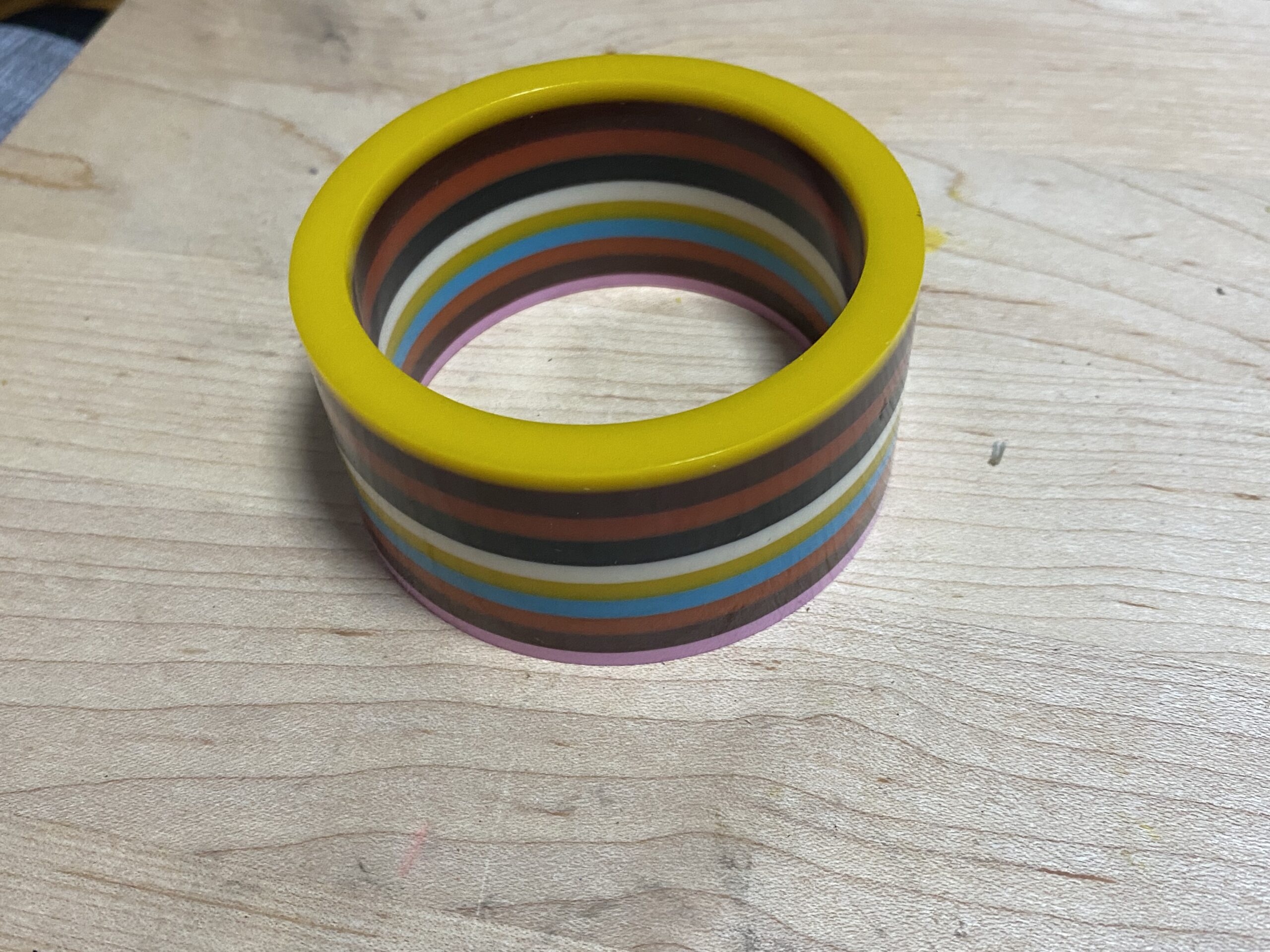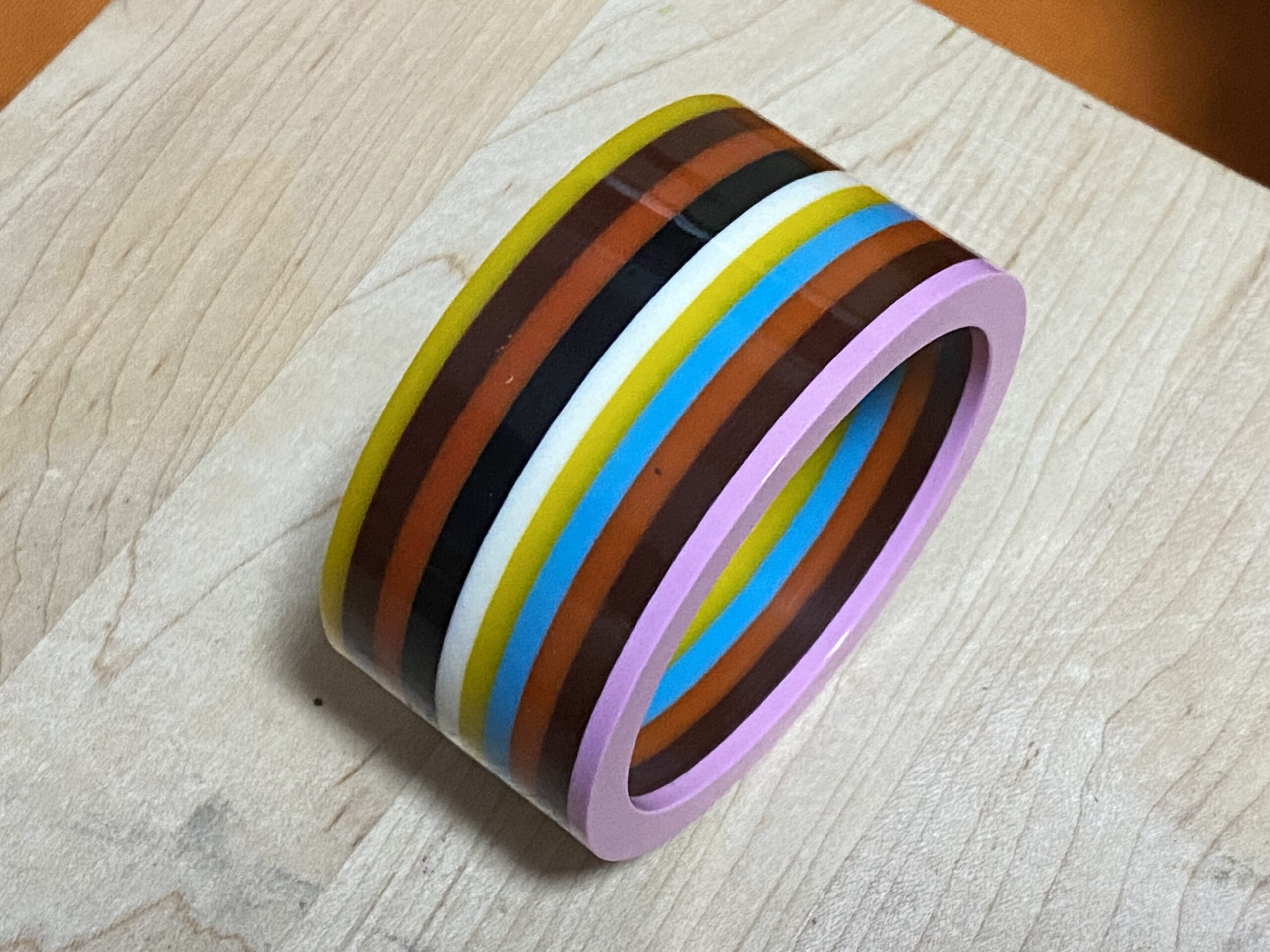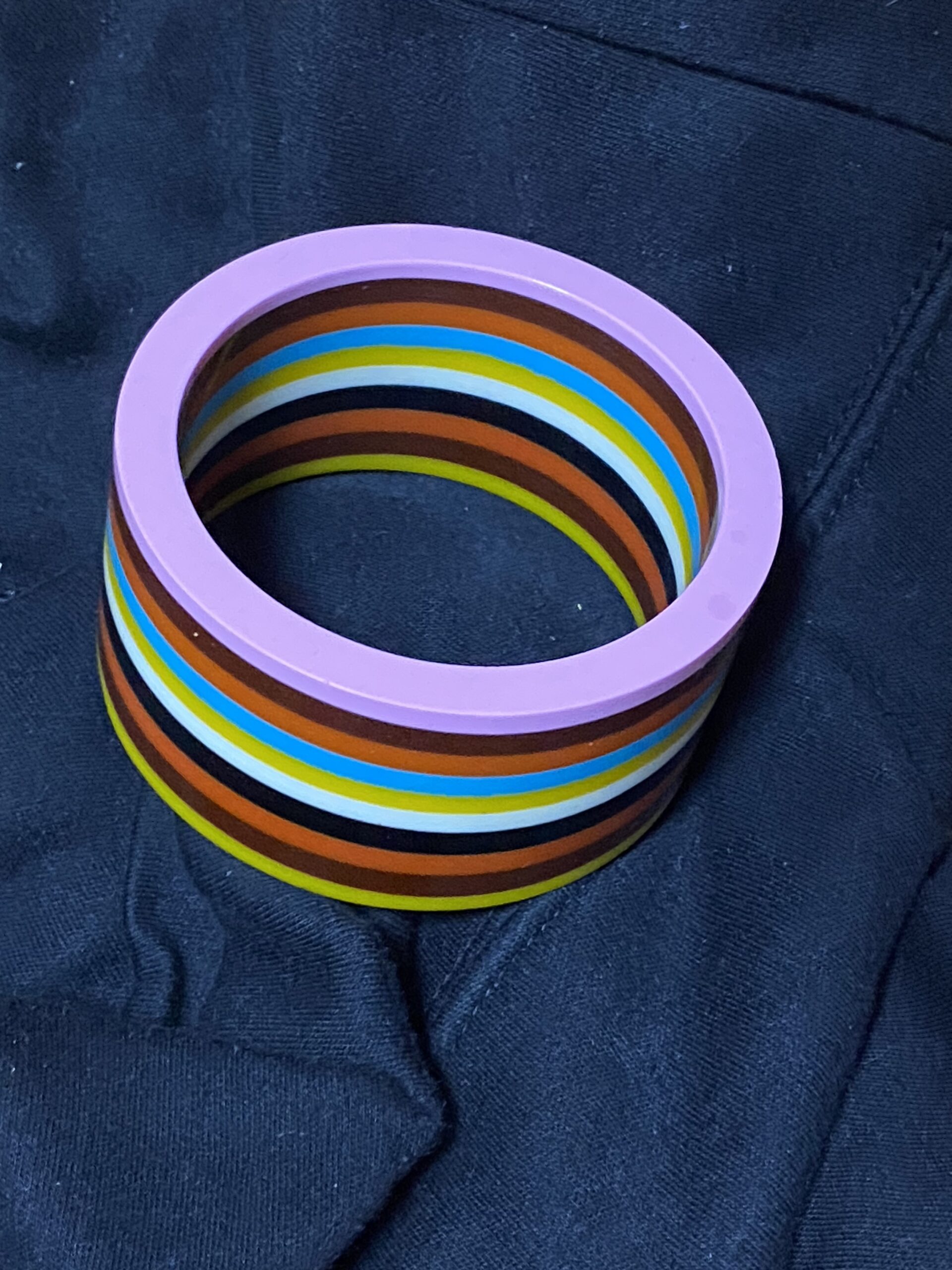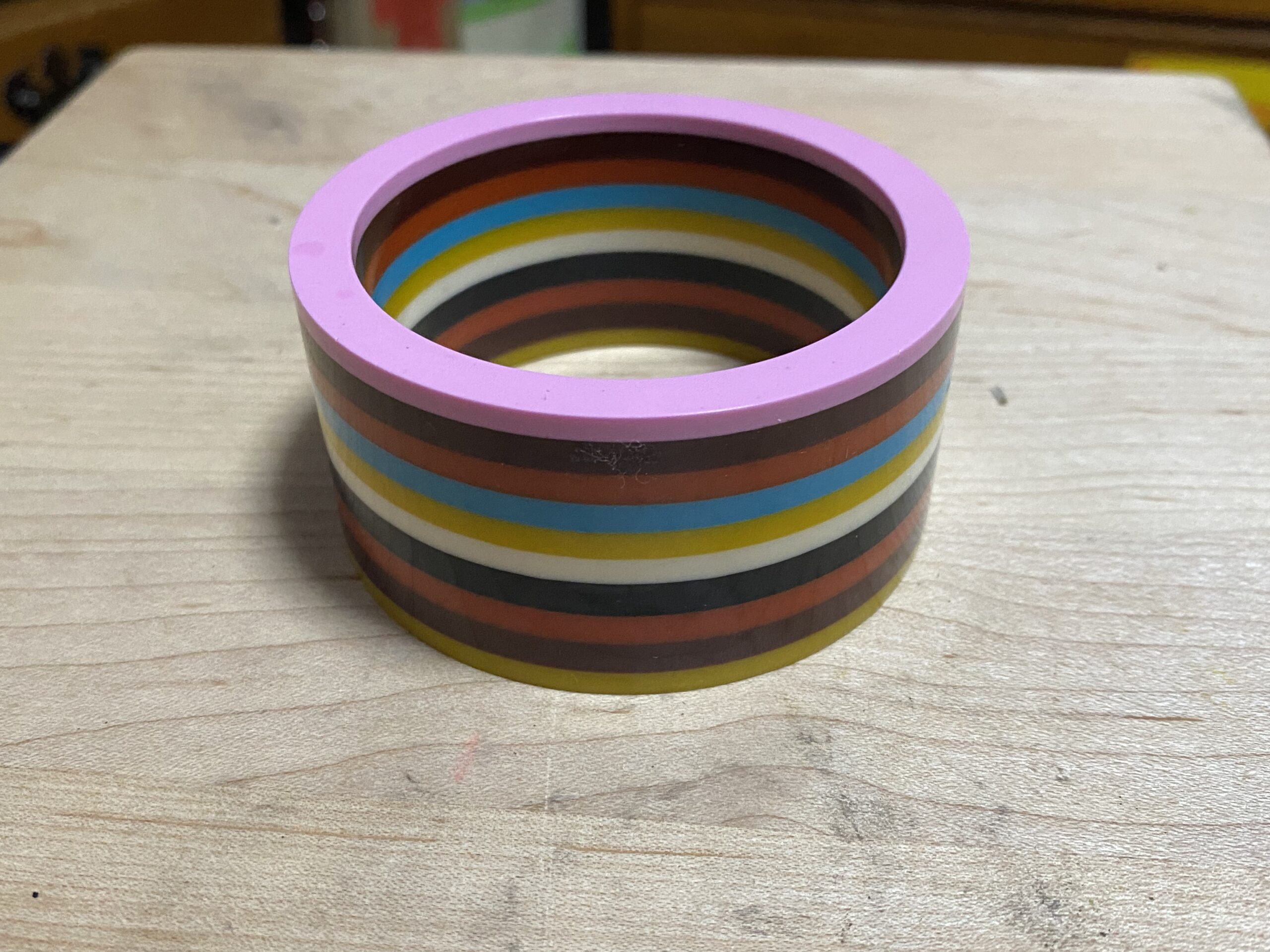Vintage (1960s?) plastic cuff bracelet tests positive for high levels of Lead, using XRF technology
October 16, 2022 — Sunday
This cuff bracelet tested positive for a high level of Lead. It is possible this is a vintage piece from the 1960s or from the ’80s — since plastic jewelry was very popular in each of those eras (if it was pre-1960, I would expect the plastic to have a rather different toxicant profile [in plastic items of this sort from previous eras, often such a piece would also test positive for high levels of Arsenic and/or Mercury]).
- For context: The amount of Lead considered unsafe in an item intended for use by children is 90 ppm Lead or higher in the paint, glaze, or coating of an item, and 100 ppm Lead or higher in the substrate (the base material of the item).
- This is an unpainted plastic item, and therefore the substrate level is the level that would apply – were this to be an (explicitly-designated) children’s item.
- So (based on the Lead levels reported below) this is positive for Lead at a level that would most definitely be considered unsafe for kids if it were manufactured today.
Unfortunately, for jewelry manufactured for use by adults (particularly vintage pieces — but also even most modern costume jewelry, too), there are no regulatory standards with total content limits for most metallic toxicants.
The problem is, this type of jewelry is also very attractive to children (and often handed down to children to use for dress-up play!), so I frequently caution grandparents and parents about that. I urge them to keep vintage jewelry (plastic, metal, crystal, and faux pearls [which are often actually Lead-painted Leaded Crystal!], etc.) away from children.
TAKEAWAY: To reiterate, most vintage materials used in jewelry making can be quite toxic — especially if they were manufactured more than 20 years ago. Additionally, even many of the new costume jewelry pieces sold as “adult” jewelry (vs. items explicitly marketed for use by children) can be quite unsafe for kids.
- To see more vintage jewelry I have tested, click here.
- To see more vintage plastic items Lead Safe Mama has tested, click here.
- To see more bracelets I have tested, click here.
- To learn more about the testing methodologies used in this work, click here.
Below is a full set of XRF test results for the vintage plastic cuff bracelet pictured.
Reading #1) On the yellow plastic edge
60-second reading
Readings are repeated multiple times to confirm the results
- Lead (Pb): 1,353 +/- 26 ppm
- Cadmium (Cd): non-detect
- Tin (Sn): non-detect
- Mercury (Hg): non-detect
- Selenium (Se): non-detect
- Barium (Ba): non-detect
- Arsenic (As): non-detect
- Chromium (Cr): 165 +/- 55 ppm
- Antimony (Sb): non-detect
- Nickel (Ni): non-detect
- Copper (Cu): 13 +/- 8 ppm
- Bromine (Br): 4 +/- 3 ppm
- Zinc (Zn): non-detect
- Titanium (Ti): non-detect
- Manganese (Mn): non-detect
- Bromine (Br): non-detect
- Indium (In): non-detect
- Bismuth (Bi): 17 +/- 9 ppm
- Zirconium (Zr): non-detect
- Niobium (Nb): non-detect
- Iron (Fe): non-detect
- Gold (Au): non-detect
- Cobalt (Co): non-detect
- Tungsten (W): non-detect
- Platinum (Pt): non-detect
- No other metals were detected in consumer goods mode.
Reading #2) On the pink plastic edge
30-second reading
Readings are repeated multiple times to confirm the results
- Lead (Pb): 478 +/- 22 ppm
- Cadmium (Cd): non-detect
- Tin (Sn): non-detect
- Mercury (Hg): non-detect
- Selenium (Se): non-detect
- Barium (Ba): non-detect
- Arsenic (As): non-detect
- Chromium (Cr): non-detect
- Antimony (Sb): non-detect
- Nickel (Ni): non-detect
- Copper (Cu): non-detect
- Bromine (Br): non-detect
- Zinc (Zn): non-detect
- Titanium (Ti): 3,490 +/- 435 ppm
- Manganese (Mn): non-detect
- Bromine (Br): 11 +/- 3 ppm
- Indium (In): non-detect
- Bismuth (Bi): non-detect
- Zirconium (Zr): non-detect
- Niobium (Nb): non-detect
- Iron (Fe): non-detect
- Gold (Au): non-detect
- Cobalt (Co): non-detect
- Tungsten (W): non-detect
- Platinum (Pt): non-detect
- No other metals were detected in consumer goods mode.
Reading #3) On the middle of the bracelet, with several colors, including red
30-second reading
Readings are repeated multiple times to confirm the results
- Lead (Pb): 1,668 +/- 40 ppm
- Cadmium (Cd): non-detect
- Tin (Sn): non-detect
- Mercury (Hg): non-detect
- Selenium (Se): non-detect
- Barium (Ba): non-detect
- Arsenic (As): non-detect
- Chromium (Cr): 167 +/- 67 ppm
- Antimony (Sb): non-detect
- Nickel (Ni): non-detect
- Copper (Cu): non-detect
- Bromine (Br): 8 +/- 4 ppm
- Zinc (Zn): non-detect
- Titanium (Ti): non-detect
- Manganese (Mn): non-detect
- Bromine (Br): non-detect
- Indium (In): non-detect
- Bismuth (Bi): non-detect
- Zirconium (Zr): non-detect
- Niobium (Nb): non-detect
- Iron (Fe): non-detect
- Gold (Au): non-detect
- Cobalt (Co): non-detect
- Tungsten (W): non-detect
- Platinum (Pt): non-detect
- No other metals were detected in consumer goods mode.
For those new to this website:
Tamara Rubin is a multiple-federal-award-winning independent advocate for childhood Lead poisoning prevention and consumer goods safety, and a documentary filmmaker. She is also a mother of Lead-poisoned children (two of her sons were acutely Lead-poisoned in 2005). Since 2009, Tamara has been using XRF technology (a scientific method used by the U.S. Consumer Product Safety Commission) to test consumer goods for toxicants (specifically heavy metals — including Lead, Cadmium, Mercury, Antimony, and Arsenic). All test results reported on this website are science-based, accurate, and replicable. Items are tested multiple times to confirm the test results for each component tested. Tamara’s work was featured in Consumer Reports Magazine in February of 2023 (March 2023 print edition).
Never Miss an Important Article Again!
Join our Email List













